Trek To Everest Base Camp With Kids: An Adventure Of A Lifetime
Can Kids Trek To Everest Base Camp?
The trek to Everest Base Camp is perhaps one of the world’s most iconic hikes and features on many people’s bucket lists. We love to push the boundaries and, in one impulsive moment, decided to trek to Everest Base Camp with our kids.
And so it was that on a clear blue sky day in mid-February, we set off from Lukla on the 81-mile (130 km) hike to base camp with our kids (11, 13, and 15 years old). It was an epic family adventure and the lessons we learned, and the memories we created during this once-in-a-lifetime trip will be retold many times over.
Everest Base Camp Trek: Overview
Mount Everest has, in fact, two Base Camps, one in Nepal and the other in Tibet. Both are used for summit attempts, with the Nepalese route to the summit widely being regarded as less technical, but still extremely challenging.
Situated at an elevation of approximately 17,600 feet (5,364 meters) above sea level, Everest Base Camp Nepal is a crucial staging point for climbers attempting to summit Everest. However, it’s not just a hub for mountaineers; it also attracts trekkers of all ages and adventure enthusiasts from around the world… including us!
The journey to Everest Base Camp is an epic adventure in its own right, taking trekkers through picturesque Sherpa villages, dense rhododendron forests, and across high suspension bridges spanning glacial rivers.
At various points along the route, the trek offers stunning panoramic views of Mount Everest and its surrounding peaks. These views add to a sense of accomplishment and connection to the highest point in the world.
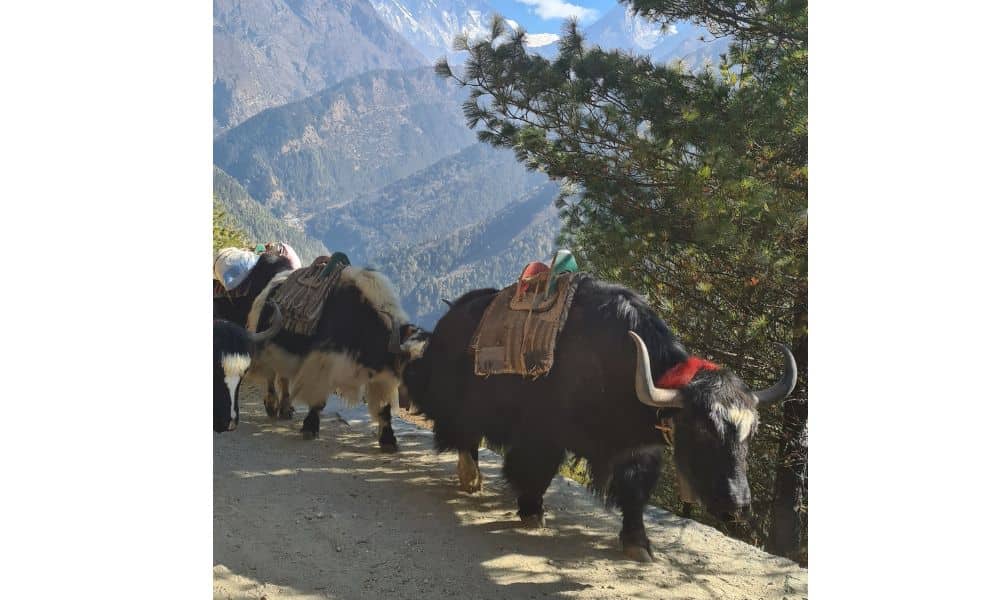
Planning To Hike Everest Base Camp With Kids
Before we delve into the adventure itself, it’s important to emphasise the significance of careful planning when trekking, especially at altitude with kids!
When Can Kids Trek To Everest Base Camp?
Ultimately, the best time to trek with kids is when they are capable of walking eight or more hours a day. Very young kids can be carried but if you plan on doing this, make sure you train accordingly!
Children can be more susceptible to altitude sickness, so they need to be able to communicate concerns or feelings of illness. Once you feel they are ready for the challenge and you are all fit and healthy, go for it.
Hire a Guide to EBC
Solo backpackers are not permitted to trek to Everest Base Camp, and a guide is required for safety and compliance. The rules do occasionally change, so do check with a reputable agent before you book.
Many companies offer guides and porters to trek to Everest Base Camp. We selected Mosaic Adventure to guide us on our trek. Like all reputable companies offering hikes to Base Camp, they asked us questions about our health, experience, mobility and fitness before agreeing to take our booking.
We confirmed a guide and three porters for our private trek only four weeks before landing in Nepal. We have hiked a lot ever since our kids were young and felt we were as prepared as possible, albeit we did not specifically train. The porters carried a maximum of 10kg of kit per hiker, leaving us around 5kg each.
Our permits were taken care of, as was our itinerary, to cater to our children’s needs and safety. Accommodation and food were included in our package
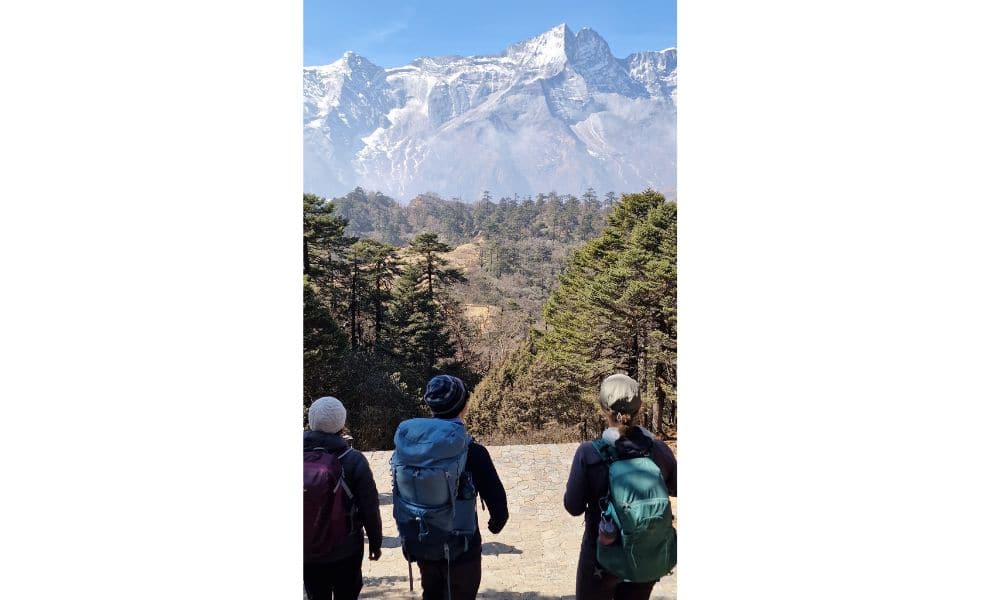
Altitude Sickness
Safety was a paramount consideration and to ensure that the Everest Base Camp Trek would be safe for us as a family, we spent months researching and meticulously preparing. We had all suffered from the effects of altitude in Peru when we had trekked the Inka Trail seven months earlier, and this time, we would be reaching 3772 feet (1149 meters) higher.
To reduce our risk of altitude sickness we planned several acclimatization days in advance of heading above 10000 feet. Once on the hike, regular hydration and fuelling meant that we were able to avoid the most severe effects and while we certainly felt the effects, we were able to continue.
kit for trekking the Himalayas with kids
A family trek to Everest Base Camp with kids is an exciting adventure, but it requires the right gear to ensure the safety and comfort of your family. Layering is essential, as are hiking boots, warm jackets, waterproofs, torches and good quality low-temperature sleeping bags.
As we were partway through a family gap year and had limited cold-weather kit, we hired sleeping bags and duffle coats from our guide. Other necessary gear was purchased in Kathmandu.
Pack only essentials; the lighter your bag, the more manageable the trek. In addition to kit, pack a variety of energy snacks and entertainment for kids during the long periods of rest time (we played lots of Uno and Monopoly Deal, as well as having e-books).
best time to visit Everest base camp
Our journey to Everest Base Camp was undertaken in late February. The weather was amazing, with clear blue skies and great views, although it was extremely cold overnight. However, the weather is generally more stable during peak season, making it the most popular time for trekking.
We took the risk of trekking before the peak season (March to May) started, hoping for minimalist crowds. The days were sunny and crisp, with clear blue skies that provided breathtaking views of the Himalayas.
The trails were in excellent condition, and we didn’t have to worry about monsoon rains (late May- September) or the extreme cold of winter (December – February).
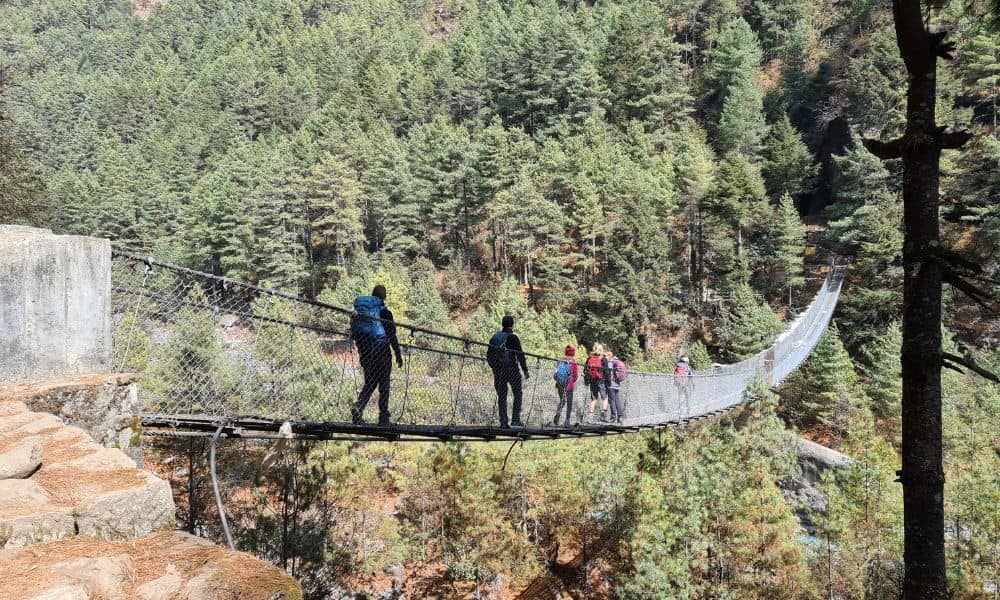
Everest Base Camp Flight: Kathmandu to Lukla
You will likely start by flying through the Himalayas from Kathmandu to Lukla. Lukla airport is deemed as one of the most dangerous runways in the world. but please don’t let that put you off! Safety is taken very seriously and all of the pilots are individually certified before being allowed to land there.
The kids were excited to board a tiny plane for the hair-raising flight to Lukla, renowned for its challenging runway. The views give you an outstanding introductory view of the mountain range.
It is common for flights to be delayed due to unfavourable weather conditions. We were lucky with perfect conditions for both our inbound and outbound flights. However, the weather can change quickly. Poor visibility closed the airport for several days while we trekking.
The Trek: Everest Base Camp With Kids
The trek to Everest Base Camp typically starts in Lukla, a small airport town serving as the Everest region’s gateway, where most travellers arrive.
We began our trek through a series of picturesque villages in the Khumbu region, such as Namche Bazaar, Tengboche, and Dingboche.
Along the way, trekkers are immersed in the rich Sherpa culture, with opportunities to visit monasteries, interact with local communities, and savour traditional Himalayan cuisine.
Each day brought new experiences and sights, from crossing suspension bridges to Yak trains and avalanches.
The journey involves acclimatisation stops to mitigate the risks of altitude sickness, which is essential due to the high elevation. Reaching Everest Base Camp is a remarkable achievement and a chance to witness firsthand the world’s highest mountain and the raw, rugged beauty of the Himalayan landscape.
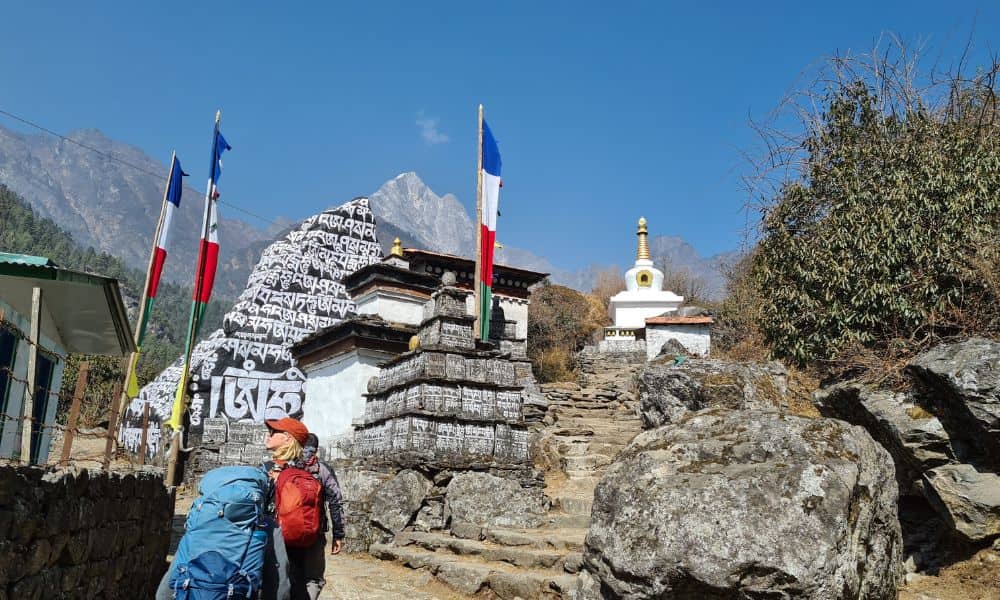
Our Everest Base Camp Trek: Itinerary
The classic return Everest Basic Camp Trek from Lukla involves different stop points to suit individuals. Additional days may be added as required.
Our itinerary was:
- Day 1 – Fly Kathmandu to Lukla + hike to Phakding (3 hour hike)
- Day 2 – Hike Phakding to Namche Bazaar (6 hour hike)
- Day 3 – Acclimatisation Hike in Namche Bazaar
- Day 4 – Hike Namche Bazaar to Tengboche (5 hour hike)
- Day 5 – Tengbouche to Dingboche (5 hour hike)
- Day 6 – Acclimatisation Hike in Dingboche
- Day 7 – Dingboche to Lobuche (7 hour hike)
- Day 8 – Lobuche to Gorak Shep, plus same-day return visit to Everest Base Camp (7 hour hike)
- Day 9 – Hike Gorak Shep to Pangboche (7 hour hike)
- Day 10 – Hike Pangboche to Phakding (9 hour hike)
- Day 11 – Hike Phakding to Lukla + flight to Kathmandu (2.5 hour hike)
Challenges Along Everest Base Camp Trek
Trekking in high-altitude conditions can be physically demanding for adults and children.
We took things slow, ensuring our kids had enough time to acclimatise, rest, and stay hydrated. Altitude sickness is a real concern, and vigilant health and well-being were monitored.
We had done a four-day altitude trek in Peru but, at 81 miles, this was our longest multi-day trek. All three kids coped amazingly well with the altitude, the adults not quite so, as we struggled to find the energy to put one step in front of the other on days 7-9 and felt like we were suffocating at night.
By day, the weather was perfect, with enough warmth from the sun, but the nights were well below freezing. The closer we got to Everest Base Camp the colder the conditions at higher altitudes. We slept in layers; the teahouses were not heated. Our water bottles were frozen solid by morning!
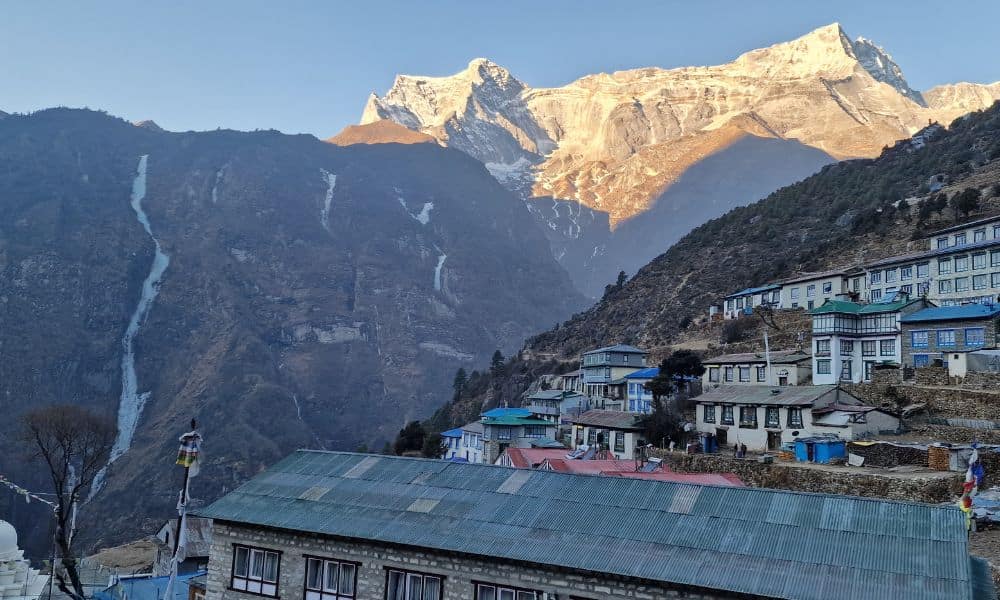
The Final Push To Everest Base Camp With Kids
The last leg of the journey took us to Gorak Shep, the final stop before reaching Everest Base Camp. The anticipation was palpable as we set out on the rocky, rugged terrain leading to our ultimate destination. Here, the struggle with reduced oxygen was real.
We arrived at Base Camp with mixed emotions – a sense of accomplishment but also awe for the towering peak of Everest. Climbers hadn’t started arriving for the season, but we could imagine their camp set up in preparation for their expedition to scale Everest.
But the challenge was not over; we were only halfway.
At this point, there was the option to do a sunrise hike to Kala Patthar, which apparently offers the most epic view of the Himalayas. We had all planned to complete this additional hike, but with the effects of altitude, there really wasn’t any other option but to skip this one.
We had three days and nights to trek back to Lukla. As we descended and our lungs refilled with oxygen, energy resumed. We saw Everest for the last time and arrived back in Lukla a day earlier than planned. We were lucky to rearrange our flight back to Kathmandu.
Life Lessons From Our Family Everest Base Camp Trek
This adventure was not just about reaching Base Camp; it was about teaching our children important life lessons. We instilled the values of perseverance, adaptability, and the ability to overcome obstacles, no matter how challenging.
This journey also fostered a deep appreciation for natural world wonders and the diverse cultures we encountered in the Everest region.
The simplicity of trekking life meant our kids embraced it, finding joy in the little things like spotting yaks and donkeys along the trail. The evenings were rewarded by quality family time, huddled around a wood burner, playing card games and drinking hot lemon and honey water.
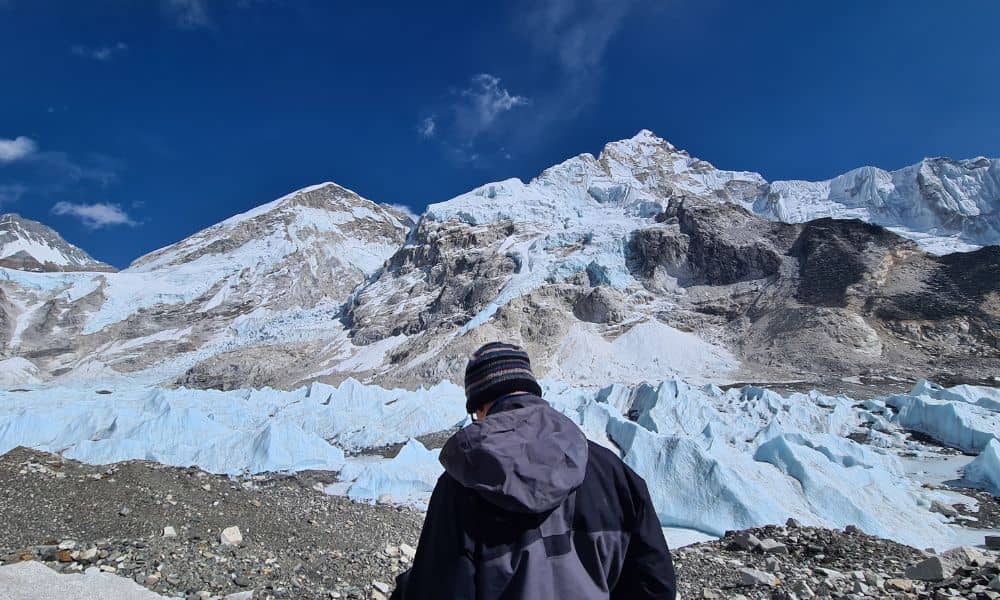
Unforgettable Moments: Everest Base Camp With Kids
Our children’s faces lit up when they first witnessed Mount Everest from Namche Bazaar and kept us in awe as we followed the view to Base Camp itself. Reaching Everest Base Camp was a serene and profound moment, surrounded by the grandeur of the Himalayas.
The journey was filled with unforgettable moments that etched themselves into our hearts forever. These moments, though physically demanding, were nothing short of magical.
From witnessing chanting in Tengboche monastery to the interaction with the families living along the route, we realized that this journey was not just about reaching a destination; it was about sharing the magic of nature and adventure with our children, creating memories that would stay with them, and us, forever.
Everest Base Camp Trek: Food And Accommodation
There are well-positioned lodges and teahouses in villages along the trail to Everest Base Camp, with the closest to Base Camp being Gorekshep. We stayed in seven different lodges and ate in several others for lunch.
Accommodation
Accommodation becomes more basic and offers fewer options the closer you get to Base Camp. However, we found each one dry and comfortable.
Rooms generally have two or three single beds, with pillows and quilts. Some rooms have ensuite showers, while others have communal toilets along the corridor. Showers are not recommended after Namche Bizare.
Rooms are not heated but the communal area is in the evenings.
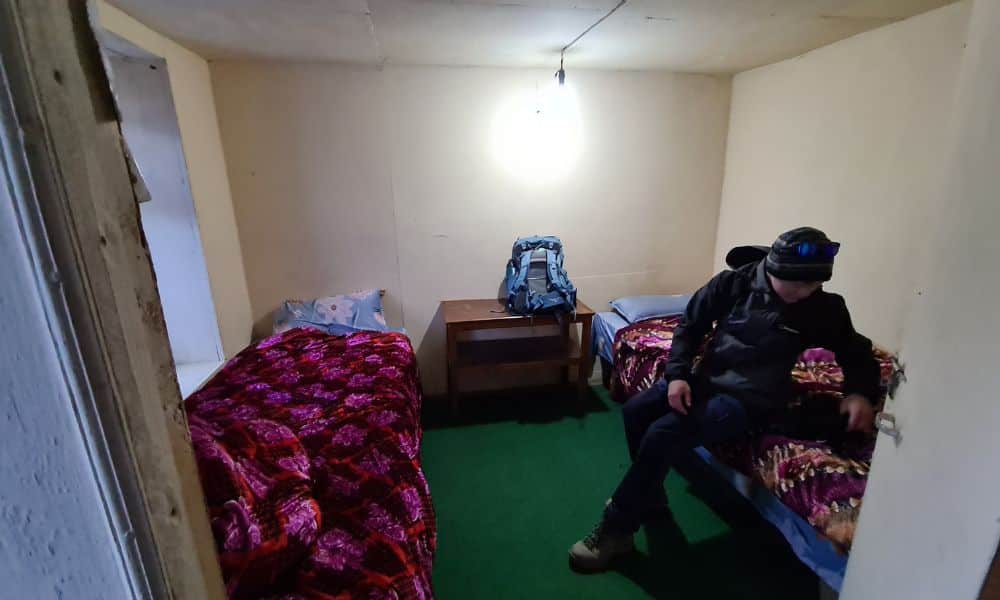
Food
Breakfast, lunch and dinner were included in our guided package, with the option to purchase further items as required. Menus had traditional Nepalese and Western food choices. It is advised not to eat meat to avoid illness.
Menu choices varied, but we mainly chose:
Breakfast: pancake, porridge, fried egg toasted sandwich.
Lunch and dinner: nasi gorang, dal bhat, thukpa, spring roll.
Villages have small shops for convenience supplies. We recommend taking a supply of snacks with you that you know your kids will eat (items also get more expensive as you trek).
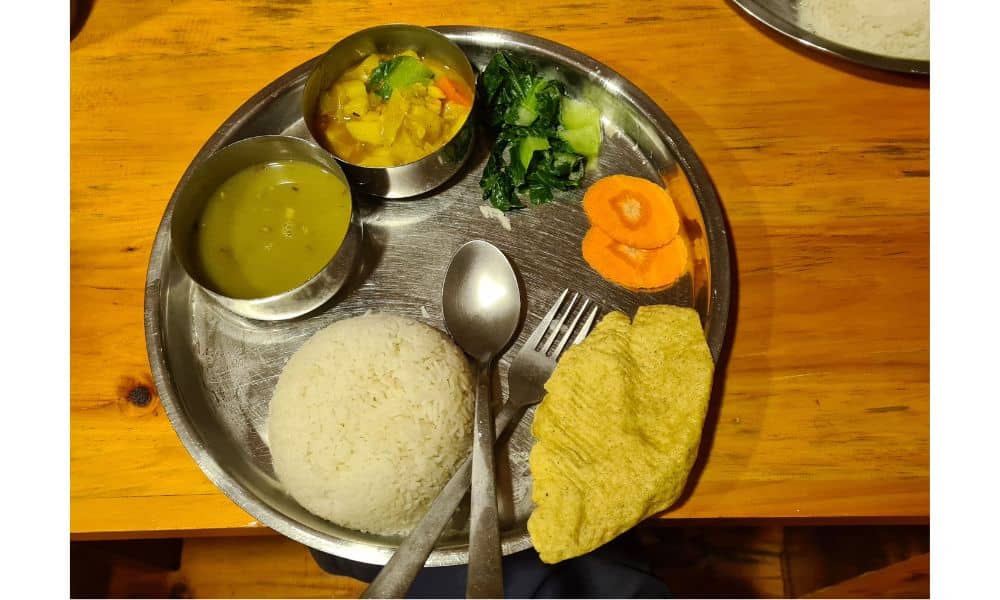
FAQ: Everest Base Camp With Kids
Is Everest Base Camp Trek Hard?
The Everest Base Camp trek is a moderate challenge if you have good physical health and fitness. The trek takes 12-14 days of walking at high altitudes, rocky tracks, and steep inclines. With the right preparations and safe trekking, it is an amazing achievement.
Can Kids trek to Everest Base Camp?
Children can trek to Everest Base Camp if they are physically fit and prepared for the challenge. It is a bucket list achievement with many benefits, such as perseverance, adaptability, and the ability to overcome obstacles, no matter how challenging.
How long does it take to hike To Everest Base Camp trek?
The classic Everest Base Camp Trek from Lukla takes 12 days, including acclimatization days. Organised packages state 14 days, which includes a day in Kathmandu on either side of the hike.
How much does it cost to trek to Everest Base Camp?
The cost of trekking to Everest Base Camp can vary widely depending on factors such as the trekking season, the trek duration, the type of accommodations chosen, and whether you choose a guided tour. You can expect to spend between $1,500 to $5,000 per person for a 12 to 16-day trek.
What is the elevation gain to Everest Base Camp?
The elevation gain to Everest Base Camp from Lukla, which is where most trekkers begin their journey, is approximately 2,500 meters (8,202 feet). The final elevation at Everest Base Camp is around 5,364 meters (17,598 feet) above sea level.
Final Thoughts: Hike Everest Base Camp With Kids
Hiking to Everest Base Camp with our kids was undoubtedly a life-changing experience. It showed us that even the most challenging adventures are possible with the right planning, determination, and the support of our family.
This journey redefined our concept of family travel and what children are capable of, leaving us with lasting memories, valuable life lessons and a sense of accomplishment that we will cherish forever.
Treks like these are an opportunity to introduce children to the wonders of the natural world and to let them experience a huge range of diverse cultures. Adding a high degree of challenge strengthens family bonds, making it a journey that’s truly worth embarking upon. If you’re considering trekking to Everest Base Camp with kids, take the leap – an experience you and your children will treasure for a lifetime.
